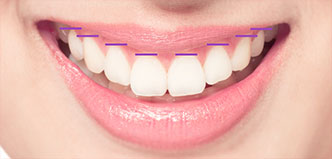
Successful treatment aims for normal occlusion (class 1). Whether or not this aim is purely orthodontic or requires maxillofacial surgery depends on the degree of dysgnathia. There is a limit to how much each tooth can be moved or tilted. In addition to normal occlusion, the position of both jaws plays a role when it comes to aesthetics. The position of the upper incisors plays a decisive role here:
An experienced maxillofacial surgeon should always be consulted if corrective jaw surgery is under consideration.

The anterior cusp (mesiobuccal; red mark) of the upper first molar (first molar; 6th) occludes in the center (buccal groove (fossa); blue mark) of the lower first molar. This position is classified as “normal” (Eugnath).

The anterior cusp (mesiobuccal; red mark) of the upper first molar occludes in front of the center (buccal groove; blue mark) of the lower first molar.

The anterior cusp (mesiobuccal; red mark) of the upper first molar occludes behind the center (buccal groove (fossa); blue mark) of the lower first molar.
The jaw deformities can manifest as a Transversalen (width of the jaw), Sagittal (too far forward or backward) or Vertical deformity (too high or too low). Evidently, the deformity can also be a combination of these three.

 Transverse
Sagittal
Vertical
Transverse
Sagittal
Vertical
Teeth play a very big role from the start - and this trend has only increased in the past few years. After all, our self-esteem and confidence also depend on our teeth - no one enjoys hiding their smile.
Oftentimes, patients who choose to visit orthodontists do so for aesthetic reasons. And we can often help them.

The incisal edges run parallel to the lower lip.

Gum tissue should not be too prominent when smiling. The shape of the gums of both large incisors should be symmetrical and slightly increase towards the back. The gum curves downward along each tooth, filling the interdental spaces. This gum is known as the interdental papilla.

The basic shape of our teeth varies from very round to very angular. What’s important is that all teeth in a single set of teeth have the same basic shape. This basic shape also leads to differences in the roundness of the incisal edge, ultimately impacting the “space” to the neighboring tooth. The space, as well as the angle of the incisal edge, increases the further back you move.

The axes of your incisors and canines run slightly towards the midline

The large/middle incisors are your dominant teeth and are therefore the longest. With little wear, canines can almost be just as long. But with increasing wear and tear, they shorten. The lateral small incisors are shorter than the central incisors.

Attractive and natural-looking teeth are bright in color, and the incisal edges vary in their translucency or light refraction. Children have relatively perfect incisal edges, with more or less pronounced bumps.


However, targeted analysis indicates that images of perfect smiles often lose their natural quality: too much symmetry, too flawless - simply uninteresting. In contrast to this, nature includes small variations. And it is precisely these variations that give you that extra something and define your individuality.
The relationship between width and length, the outline of your face (oval, sharp, etc.), the profile and fullness of your lips, the shape of your nose and the prominence of your chin are all influenced by your jaw. An underbite, for example, significantly reduces the fullness of your lips, but also makes your nose look bigger given that it starts on the same axis as your chin. Since the relationship between upper and lower jaw isn’t proportional in this instance, the untrained eye might think the lower jaw is too large.